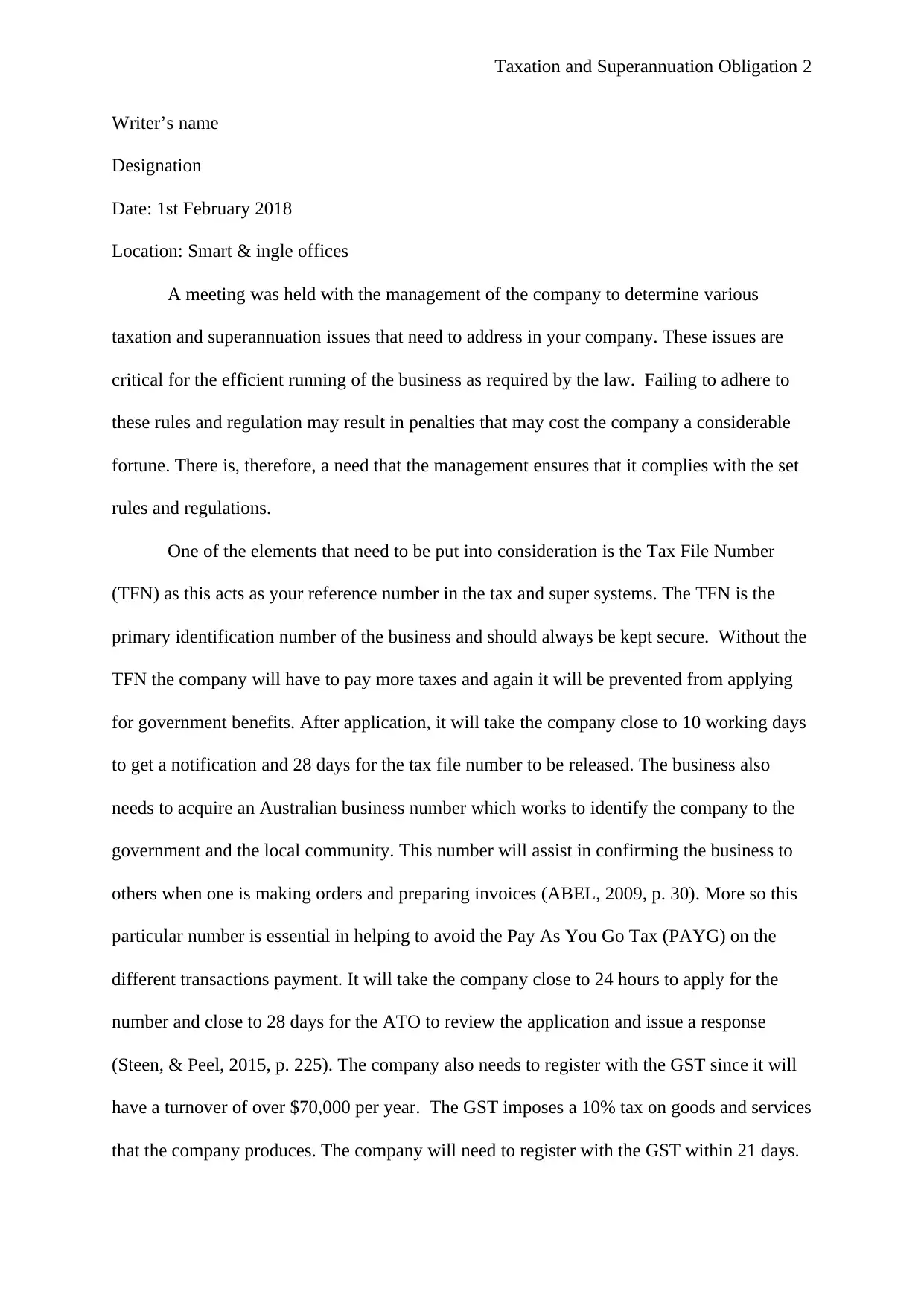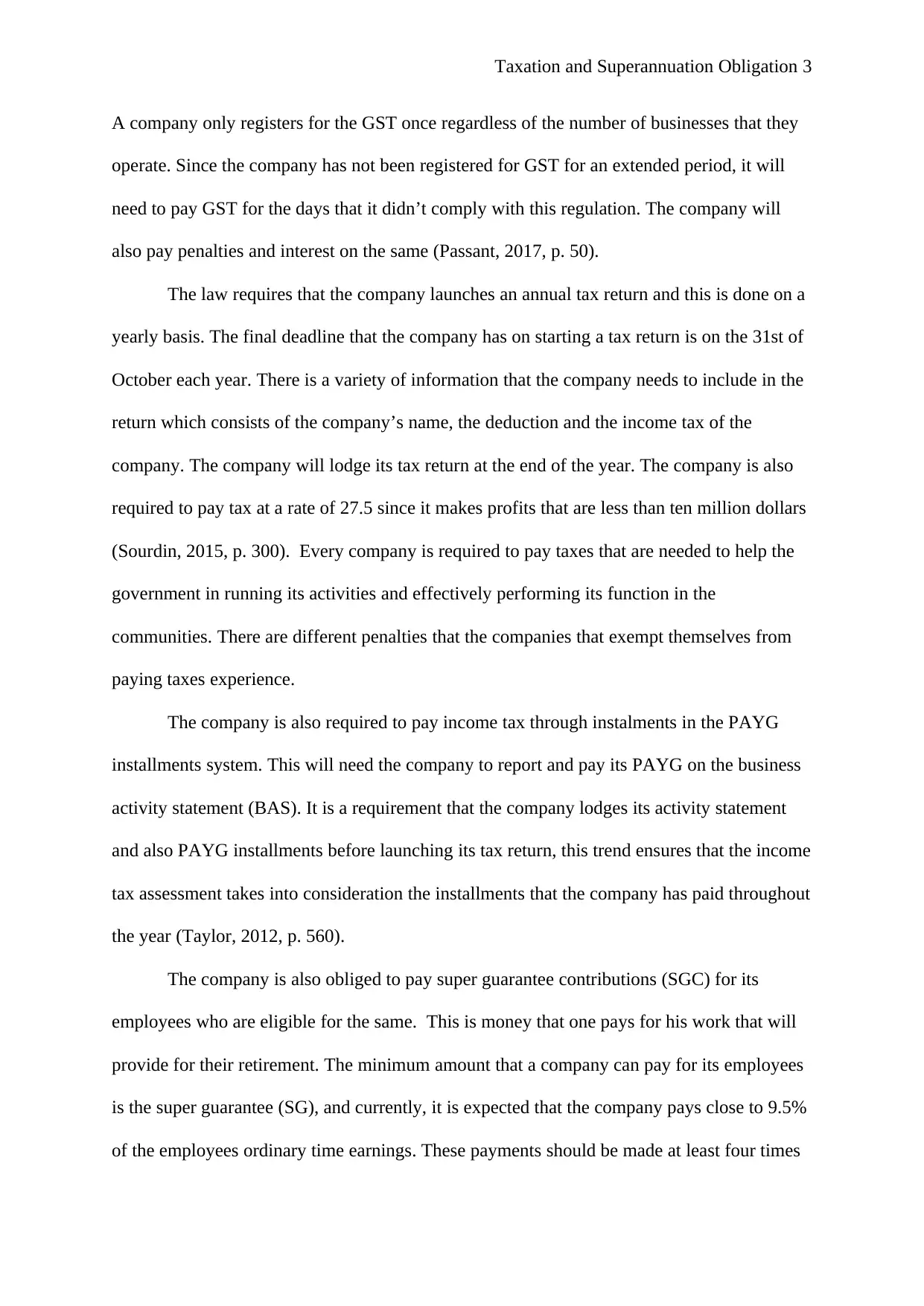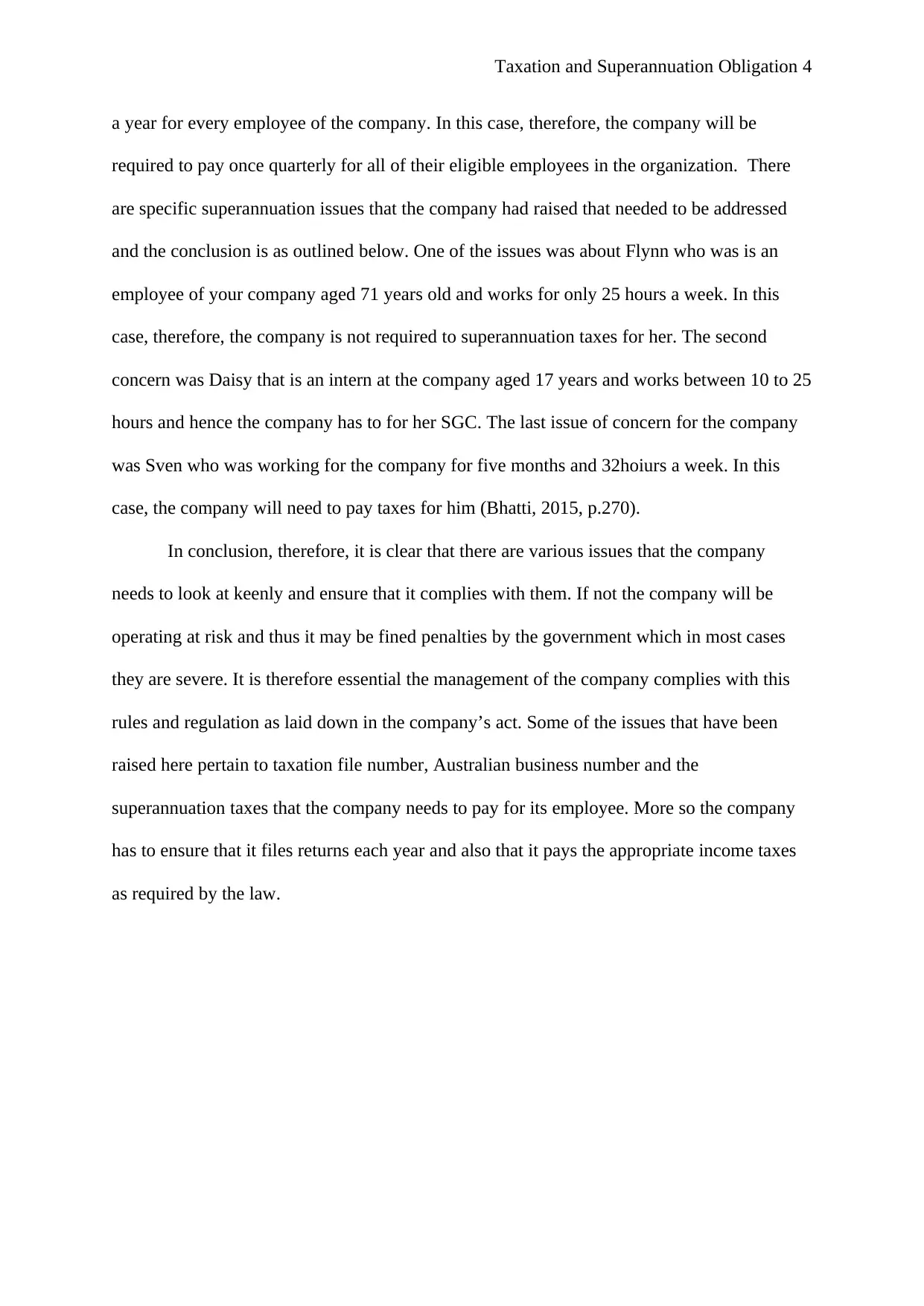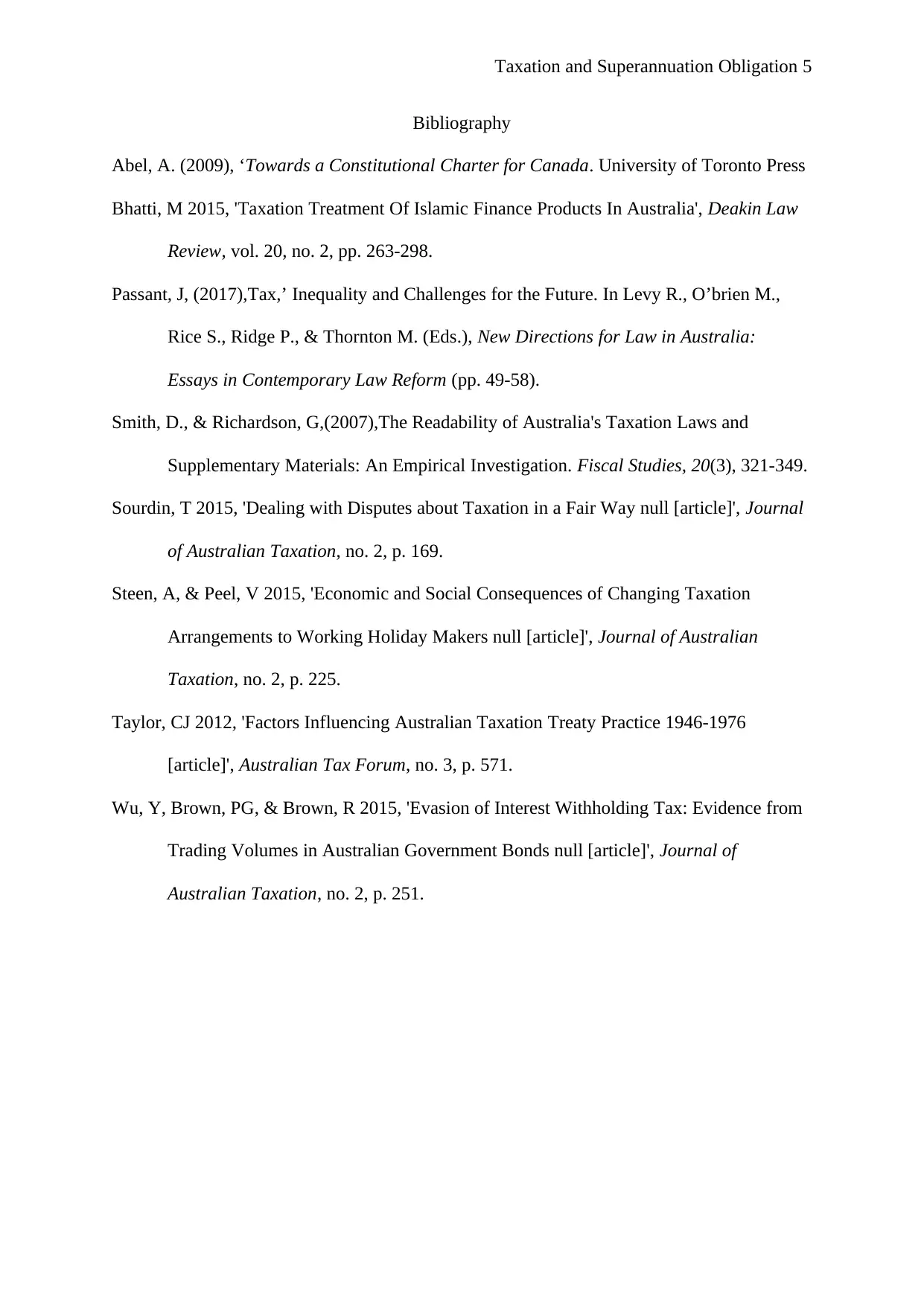Analysis of Taxation and Superannuation Obligations for Businesses
VerifiedAdded on 2023/06/12
|5
|1441
|440
Report
AI Summary
This report provides a detailed overview of taxation and superannuation obligations for businesses, emphasizing the importance of compliance with regulations to avoid penalties. It covers essential elements such as obtaining a Tax File Number (TFN) and an Australian Business Number (ABN), registering for Goods and Services Tax (GST) when turnover exceeds $70,000, and adhering to annual tax return deadlines. The report also discusses the Pay As You Go (PAYG) installment system for income tax and the requirement to pay super guarantee contributions (SGC) for eligible employees, currently at 9.5% of ordinary time earnings. Specific superannuation issues related to employees of different ages and working hours are addressed, clarifying the company's obligations in each scenario. The report concludes by stressing the need for management to comply with these rules and regulations to ensure the business operates without risking fines or penalties.

Taxation and Superannuation Obligation 1
Taxation and Superannuation Obligation
Student name
Course Title
Professor’s Name
University
City and State
Date
Taxation and Superannuation Obligation
Student name
Course Title
Professor’s Name
University
City and State
Date
Paraphrase This Document
Need a fresh take? Get an instant paraphrase of this document with our AI Paraphraser

Taxation and Superannuation Obligation 2
Writer’s name
Designation
Date: 1st February 2018
Location: Smart & ingle offices
A meeting was held with the management of the company to determine various
taxation and superannuation issues that need to address in your company. These issues are
critical for the efficient running of the business as required by the law. Failing to adhere to
these rules and regulation may result in penalties that may cost the company a considerable
fortune. There is, therefore, a need that the management ensures that it complies with the set
rules and regulations.
One of the elements that need to be put into consideration is the Tax File Number
(TFN) as this acts as your reference number in the tax and super systems. The TFN is the
primary identification number of the business and should always be kept secure. Without the
TFN the company will have to pay more taxes and again it will be prevented from applying
for government benefits. After application, it will take the company close to 10 working days
to get a notification and 28 days for the tax file number to be released. The business also
needs to acquire an Australian business number which works to identify the company to the
government and the local community. This number will assist in confirming the business to
others when one is making orders and preparing invoices (ABEL, 2009, p. 30). More so this
particular number is essential in helping to avoid the Pay As You Go Tax (PAYG) on the
different transactions payment. It will take the company close to 24 hours to apply for the
number and close to 28 days for the ATO to review the application and issue a response
(Steen, & Peel, 2015, p. 225). The company also needs to register with the GST since it will
have a turnover of over $70,000 per year. The GST imposes a 10% tax on goods and services
that the company produces. The company will need to register with the GST within 21 days.
Writer’s name
Designation
Date: 1st February 2018
Location: Smart & ingle offices
A meeting was held with the management of the company to determine various
taxation and superannuation issues that need to address in your company. These issues are
critical for the efficient running of the business as required by the law. Failing to adhere to
these rules and regulation may result in penalties that may cost the company a considerable
fortune. There is, therefore, a need that the management ensures that it complies with the set
rules and regulations.
One of the elements that need to be put into consideration is the Tax File Number
(TFN) as this acts as your reference number in the tax and super systems. The TFN is the
primary identification number of the business and should always be kept secure. Without the
TFN the company will have to pay more taxes and again it will be prevented from applying
for government benefits. After application, it will take the company close to 10 working days
to get a notification and 28 days for the tax file number to be released. The business also
needs to acquire an Australian business number which works to identify the company to the
government and the local community. This number will assist in confirming the business to
others when one is making orders and preparing invoices (ABEL, 2009, p. 30). More so this
particular number is essential in helping to avoid the Pay As You Go Tax (PAYG) on the
different transactions payment. It will take the company close to 24 hours to apply for the
number and close to 28 days for the ATO to review the application and issue a response
(Steen, & Peel, 2015, p. 225). The company also needs to register with the GST since it will
have a turnover of over $70,000 per year. The GST imposes a 10% tax on goods and services
that the company produces. The company will need to register with the GST within 21 days.

Taxation and Superannuation Obligation 3
A company only registers for the GST once regardless of the number of businesses that they
operate. Since the company has not been registered for GST for an extended period, it will
need to pay GST for the days that it didn’t comply with this regulation. The company will
also pay penalties and interest on the same (Passant, 2017, p. 50).
The law requires that the company launches an annual tax return and this is done on a
yearly basis. The final deadline that the company has on starting a tax return is on the 31st of
October each year. There is a variety of information that the company needs to include in the
return which consists of the company’s name, the deduction and the income tax of the
company. The company will lodge its tax return at the end of the year. The company is also
required to pay tax at a rate of 27.5 since it makes profits that are less than ten million dollars
(Sourdin, 2015, p. 300). Every company is required to pay taxes that are needed to help the
government in running its activities and effectively performing its function in the
communities. There are different penalties that the companies that exempt themselves from
paying taxes experience.
The company is also required to pay income tax through instalments in the PAYG
installments system. This will need the company to report and pay its PAYG on the business
activity statement (BAS). It is a requirement that the company lodges its activity statement
and also PAYG installments before launching its tax return, this trend ensures that the income
tax assessment takes into consideration the installments that the company has paid throughout
the year (Taylor, 2012, p. 560).
The company is also obliged to pay super guarantee contributions (SGC) for its
employees who are eligible for the same. This is money that one pays for his work that will
provide for their retirement. The minimum amount that a company can pay for its employees
is the super guarantee (SG), and currently, it is expected that the company pays close to 9.5%
of the employees ordinary time earnings. These payments should be made at least four times
A company only registers for the GST once regardless of the number of businesses that they
operate. Since the company has not been registered for GST for an extended period, it will
need to pay GST for the days that it didn’t comply with this regulation. The company will
also pay penalties and interest on the same (Passant, 2017, p. 50).
The law requires that the company launches an annual tax return and this is done on a
yearly basis. The final deadline that the company has on starting a tax return is on the 31st of
October each year. There is a variety of information that the company needs to include in the
return which consists of the company’s name, the deduction and the income tax of the
company. The company will lodge its tax return at the end of the year. The company is also
required to pay tax at a rate of 27.5 since it makes profits that are less than ten million dollars
(Sourdin, 2015, p. 300). Every company is required to pay taxes that are needed to help the
government in running its activities and effectively performing its function in the
communities. There are different penalties that the companies that exempt themselves from
paying taxes experience.
The company is also required to pay income tax through instalments in the PAYG
installments system. This will need the company to report and pay its PAYG on the business
activity statement (BAS). It is a requirement that the company lodges its activity statement
and also PAYG installments before launching its tax return, this trend ensures that the income
tax assessment takes into consideration the installments that the company has paid throughout
the year (Taylor, 2012, p. 560).
The company is also obliged to pay super guarantee contributions (SGC) for its
employees who are eligible for the same. This is money that one pays for his work that will
provide for their retirement. The minimum amount that a company can pay for its employees
is the super guarantee (SG), and currently, it is expected that the company pays close to 9.5%
of the employees ordinary time earnings. These payments should be made at least four times
⊘ This is a preview!⊘
Do you want full access?
Subscribe today to unlock all pages.

Trusted by 1+ million students worldwide

Taxation and Superannuation Obligation 4
a year for every employee of the company. In this case, therefore, the company will be
required to pay once quarterly for all of their eligible employees in the organization. There
are specific superannuation issues that the company had raised that needed to be addressed
and the conclusion is as outlined below. One of the issues was about Flynn who was is an
employee of your company aged 71 years old and works for only 25 hours a week. In this
case, therefore, the company is not required to superannuation taxes for her. The second
concern was Daisy that is an intern at the company aged 17 years and works between 10 to 25
hours and hence the company has to for her SGC. The last issue of concern for the company
was Sven who was working for the company for five months and 32hoiurs a week. In this
case, the company will need to pay taxes for him (Bhatti, 2015, p.270).
In conclusion, therefore, it is clear that there are various issues that the company
needs to look at keenly and ensure that it complies with them. If not the company will be
operating at risk and thus it may be fined penalties by the government which in most cases
they are severe. It is therefore essential the management of the company complies with this
rules and regulation as laid down in the company’s act. Some of the issues that have been
raised here pertain to taxation file number, Australian business number and the
superannuation taxes that the company needs to pay for its employee. More so the company
has to ensure that it files returns each year and also that it pays the appropriate income taxes
as required by the law.
a year for every employee of the company. In this case, therefore, the company will be
required to pay once quarterly for all of their eligible employees in the organization. There
are specific superannuation issues that the company had raised that needed to be addressed
and the conclusion is as outlined below. One of the issues was about Flynn who was is an
employee of your company aged 71 years old and works for only 25 hours a week. In this
case, therefore, the company is not required to superannuation taxes for her. The second
concern was Daisy that is an intern at the company aged 17 years and works between 10 to 25
hours and hence the company has to for her SGC. The last issue of concern for the company
was Sven who was working for the company for five months and 32hoiurs a week. In this
case, the company will need to pay taxes for him (Bhatti, 2015, p.270).
In conclusion, therefore, it is clear that there are various issues that the company
needs to look at keenly and ensure that it complies with them. If not the company will be
operating at risk and thus it may be fined penalties by the government which in most cases
they are severe. It is therefore essential the management of the company complies with this
rules and regulation as laid down in the company’s act. Some of the issues that have been
raised here pertain to taxation file number, Australian business number and the
superannuation taxes that the company needs to pay for its employee. More so the company
has to ensure that it files returns each year and also that it pays the appropriate income taxes
as required by the law.
Paraphrase This Document
Need a fresh take? Get an instant paraphrase of this document with our AI Paraphraser

Taxation and Superannuation Obligation 5
Bibliography
Abel, A. (2009), ‘Towards a Constitutional Charter for Canada. University of Toronto Press
Bhatti, M 2015, 'Taxation Treatment Of Islamic Finance Products In Australia', Deakin Law
Review, vol. 20, no. 2, pp. 263-298.
Passant, J, (2017),Tax,’ Inequality and Challenges for the Future. In Levy R., O’brien M.,
Rice S., Ridge P., & Thornton M. (Eds.), New Directions for Law in Australia:
Essays in Contemporary Law Reform (pp. 49-58).
Smith, D., & Richardson, G,(2007),The Readability of Australia's Taxation Laws and
Supplementary Materials: An Empirical Investigation. Fiscal Studies, 20(3), 321-349.
Sourdin, T 2015, 'Dealing with Disputes about Taxation in a Fair Way null [article]', Journal
of Australian Taxation, no. 2, p. 169.
Steen, A, & Peel, V 2015, 'Economic and Social Consequences of Changing Taxation
Arrangements to Working Holiday Makers null [article]', Journal of Australian
Taxation, no. 2, p. 225.
Taylor, CJ 2012, 'Factors Influencing Australian Taxation Treaty Practice 1946-1976
[article]', Australian Tax Forum, no. 3, p. 571.
Wu, Y, Brown, PG, & Brown, R 2015, 'Evasion of Interest Withholding Tax: Evidence from
Trading Volumes in Australian Government Bonds null [article]', Journal of
Australian Taxation, no. 2, p. 251.
Bibliography
Abel, A. (2009), ‘Towards a Constitutional Charter for Canada. University of Toronto Press
Bhatti, M 2015, 'Taxation Treatment Of Islamic Finance Products In Australia', Deakin Law
Review, vol. 20, no. 2, pp. 263-298.
Passant, J, (2017),Tax,’ Inequality and Challenges for the Future. In Levy R., O’brien M.,
Rice S., Ridge P., & Thornton M. (Eds.), New Directions for Law in Australia:
Essays in Contemporary Law Reform (pp. 49-58).
Smith, D., & Richardson, G,(2007),The Readability of Australia's Taxation Laws and
Supplementary Materials: An Empirical Investigation. Fiscal Studies, 20(3), 321-349.
Sourdin, T 2015, 'Dealing with Disputes about Taxation in a Fair Way null [article]', Journal
of Australian Taxation, no. 2, p. 169.
Steen, A, & Peel, V 2015, 'Economic and Social Consequences of Changing Taxation
Arrangements to Working Holiday Makers null [article]', Journal of Australian
Taxation, no. 2, p. 225.
Taylor, CJ 2012, 'Factors Influencing Australian Taxation Treaty Practice 1946-1976
[article]', Australian Tax Forum, no. 3, p. 571.
Wu, Y, Brown, PG, & Brown, R 2015, 'Evasion of Interest Withholding Tax: Evidence from
Trading Volumes in Australian Government Bonds null [article]', Journal of
Australian Taxation, no. 2, p. 251.
1 out of 5
Related Documents
Your All-in-One AI-Powered Toolkit for Academic Success.
+13062052269
info@desklib.com
Available 24*7 on WhatsApp / Email
![[object Object]](/_next/static/media/star-bottom.7253800d.svg)
Unlock your academic potential
Copyright © 2020–2025 A2Z Services. All Rights Reserved. Developed and managed by ZUCOL.





